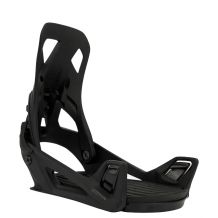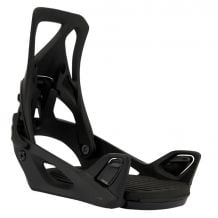When considering your equipment for the next snowboarding season, the choice of bindings is one of the most important aspects. There are many different types of bindings, but quick-release snowboard bindings stand out for their practicality and speed of use. Let's find out together what a quick release binding is, and compare the different models on the market to help you choose the one that's right for you.
What is a quick release binding?
A quick-release binding is a type of snowboard binding designed to make it easier to put boots on and take them off the snowboard, and thus avoid a lot of handling. Unlike traditional bindings, which require you to bend down to adjust straps and buckles, quick-release bindings are designed to allow easier entry and exit.
These bindings typically use a quick-release mechanism that allows riders to slide their foot into the binding without having to kneel or sit down to adjust the straps. Once the foot is in place, the release mechanism locks to hold the foot securely in place.
.png) |
What are the main brands and bindings?
Flow bindings
Flow bindings, also known as rear-entry bindings, are a revolutionary type of snowboard binding that were introduced to the market in the 1990s. The key innovation of Flow bindings lies in their easy-entry system, which allows snowboarders to put on their bindings quickly without having to sit or kneel to fasten them.
The history of Flow bindings goes back to 1992, when Flow founder Martin Gallant designed the first prototype. These bindings featured a folding rear strap, enabling snowboarders to simply slide their foot into the binding from the rear, fold the strap over and secure their boot quickly and easily.
Flow bindings quickly gained in popularity due to their practicality, especially for beginners who often find attaching traditional bindings tedious. However, they have also sparked debate among more experienced snowboarders as to their performance and control.
Over the years, Flow binding technology has evolved to improve responsiveness, lightness and comfort. Many snowboard brands have developed their own versions of Flow bindings, while retaining the fundamental idea of fast rear entry.
Nidecker Supermatic
The Nidecker Supermatic binding is a revolution in the world of snowboarding, being the first universal double-entry automatic binding. Unlike many previous unsuccessful attempts, the Supermatic requires no special boots, works well in powder, and offers the comfort and reliability of a two-strap binding.
The Supermatic is made from high-quality materials, such as fiberglass-infused nylon for the baseplate, a Slip-N-Grip plate for easy foot entry, and a heel roller to simplify the boot insertion process. What's more, the Asym Hadron nylon spoiler offers a perfect fit, responsive flex and a forward tilt adjuster for complete customization.
Burton's Step On
Burton's Step On® system was created as a result of Jake Burton Carpenter's challenge in the early 2010s to develop easier-to-use snowboard bindings and boots to improve the learning and enjoyment of snowboarding. After five years of research and development, the Step On system was launched in 2017.
This system consists of snowboard boots and bindings specially designed to be used together. It anchors the boot to the binding thanks to three locking points: two front cleats and a heel cleat. The front cleats on the front of each boot align perfectly with Burton's Step On front hooks, offering maximum toe responsiveness. At the same time, the boot's heel cleat locks into the binding's rear hook with a release lever for quick on and off. This system offers ease of use, comfort and performance for snowboarders.
.png) |
What are the different types of bindings?
All snowboard bindings are designed to be versatile and capable of adapting to different types of terrain. However, some bindings perform better when it comes to executing technical tricks in a snowpark, while others perform better when tackling couloirs, steep slopes or powder fields. This change in performance is due to a number of factors, principally the flexibility of the binding, but also the shape, height or inclination of the spoiler.
Freestyle snowboard bindings
Freestyle snowboard bindings are usually characterized by their flexibility, comfort and cushioning. They frequently feature asymmetrical spoilers with a hollowed-out profile to accentuate flexibility and lightness, with the aim of providing maximum mobility. Shorter spoilers offer better forgiveness and generally greater lateral freedom of movement. They're perfect for adjusting your holds or executing presses without requiring excessive effort on your bindings.
Freeride snowboard bindings
Freeride bindings are specially designed to give snowboarders optimal control and responsiveness, guaranteeing impeccable performance in technical sections. These bindings feature increased rigidity, reinforced by the use of robust materials and higher spoilers. They are aimed primarily at experienced snowboarders who prefer a powerful ride, requiring more intense physical involvement, with no margin for error.
Versatile or All-Mountain snowboard bindings
Versatile bindings, also known as All-Mountain bindings, offer a perfect balance between the two extremes. Their intermediate level of flexibility makes them supple enough to enjoy freestyle riding, while providing the support and precision required to evolve on various types of terrain. These bindings have no particular terrain of choice, making them suitable for a varied day, allowing you to navigate between fresh snow, carving and the snowpark without compromise.
It's important to remember that there are noset rules, and that every rider will have his or her own preferences and feel comfortable with certain bindings, while others will not. Snowboarding is first and foremost a question of personal feeling, and our best advice would be to experiment with different models before making a purchase, in order to better understand your own preferences and expectations.
Which quick release for which practice?
At Flow, you'll find the binding to suit your needs!
Flow has been in the binding business for many years, and their technology has been adopted by the snowboarding world, which is why they've created numerous models to suit all levels and styles. The fenix, for example, is an intermediate binding suitable for all types of terrain, while the Nx2 Hybrid will delight advanced/experts looking for a binding capable of handling powerful thrusts.
Nidecker's supermatic, a versatile binding par excellence!
The Nidecker team considers this binding to be the most comfortable to date. It has been tested in a variety of conditions, from groomed pistes to steep freeride lines and the park, by different types of riders, and has proved to be a reliable fast entry system. Whether you're tired of adjusting straps or want to save time at the lift, the Supermatic is the future of snowboarding.
Burton Step On bindings for everyone!
Burton has created 3 models of Step On bindings to suit every riding style. The first model is the Step On, a piste-oriented binding for intermediate snowboarders who want comfort and practicality. The Step On Genesis binding offers comfort, performance and practicality for demanding All-Mountain riders. A top-of-the-range model in the Step On range, the Step On X is made from Nylon and Carbon to give you the power to go downhill. This binding will excel in carving on piste as well as in big powder fields for advanced/expert snowboarders looking for sensation and fun.
Are the bindings compatible with all boards?
Once you've chosen a binding model, you need to make sure it's compatible with the different insert systems. There are 4 different systems:
The 2x4 system (2 x 4 cm) is widely used in the snowboard industry. These dimensions correspond to the vertical distance between each insert hole, i.e. 2 centimeters, and the spacing between the two rows of holes, i.e. 4 centimeters, across the width of the board. In general, boards with this system offer 12 holes for each fastener, making them compatible with most fasteners.
The 4x4 system (4 cm x 4 cm) is very similar to the 2x4, and operates in the same way. By placing the binding disc over the holes in the board, of which there are usually 6 per binding, you can adjust them to suit your preferences. Like the 2x4 system, 4x4 inserts are compatible with most bindings on the market, with the exception of Burton EST bindings.
Increasingly rare, Burton 3D inserts were originally designed for Burton boards. This triangular-shaped system does not work with 2x4 or 4x4 binding discs, and requires the use of a specific disc. However, most manufacturers include compatibility discs with their bindings, allowing you to mount them on a board equipped with the Burton 3D system.
The Channel system, formerly known as ICS, is a patented technology developed by Burton. It is easily identifiable by its long, narrow notch designed to accommodate each binding. Exclusively available on Burton boards, The Channel system offers a multitude of options for adjusting your riding position to suit your preferences.
You'll find a table below listing the compatibility of the bindings with the different insert types.
| Flow | Supermatic | Step On | |
| 2x4 system | X | X | X |
| 4x4 system | X | X | X |
| Burton 3D insert | X | X | |
| The Channel system | X | X | X |
Discover our selection of snowboards
How to use the different bindings?
With Flow bindings, it's all about the spoiler!
Flow bindings are rear-entry bindings, so using them couldn't be easier. First, open the binding's spoiler to create a gap at the rear of the binding. Once this gap is open, simply slip the boot into the binding, then raise the spoiler to close the binding. When you want to remove your foot from the binding, you need to do exactly the same thing: open the spoiler, remove the foot from the binding, then raise the spoiler. This quick-release rear-entry bracket requires a few manipulations, but saves time compared to a conventional bracket.
.png) |
Supermatic, no more than a heel strike!
Supermatic is even simpler! Simplyinsert your foot through the rear of the binding andpress the heel pedal to activate the binding automatically. Once you've done that, you're ready to get on your snowboard. For a quick release, simply use the release lever. The straps are designed with the same AuxTech comfort as our classic high-end bindings. Set them to your preference once, then lock them using the locking pawls to get a perfect fit every time. If conditions on the slope or in the snow demand it, you even have the option of using them as classic bindings.
.png) |
Step On, one click and off you go!
The Step On binding is the quickest and easiest to use, thanks to an ingenious system of inserts that allow you to secure the boot in the binding in a record time of just 3 seconds. There's no need for straps, as the retention points at the front, around the ankle and on each side of the foot ensure a perfect fit. To release the shoe in a single movement, use the lever on the side of the binding. As you can see, this system relies on the compatibility between the binding and the shoe, so that the shoe has the essential connection points to hold the assembly in place.
.png) |
Are bindings compatible with all boots?
As you may have gathered, some bindings require a specific boot. As the Flow and Supermatic bindings are based solely on a mechanism in the binding, they are compatible with all types of boots - well, almost. Yes, almost. Unlike their competitors, Burton's Step On bindings are only compatible with Step On boots, which are equipped with a system that clips the boot to the binding. Step On boots will therefore not be compatible with other types of bindings.
See our full selection of snowboard boots.
Our opinion on Flow bindings
Flow bindings are quick and easy to put on, although you'll need to use your hands to secure the binding with your boots. Their range of bindings is very wide, so you'll be able to find a binding to suit your level and riding style.
Burton created the Step On binding to save you time, and it works! With this binding, you can put on your boots in 3 seconds without losing any performance, and that's a treat. However, the bindings are only compatible with Step On shoes, which is their big drawback.
Our favorite is Nidecker's Supermatic binding. It embodies versatility, skilfully balancing responsiveness and flexibility to suit different styles and levels. Putting on this binding is super-fast and fun, and it's compatible with all snowboard boots, unlike the Step On.
 |




















